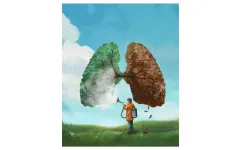(Press-News.org) Blood vessels in the lungs aren’t like the others in the body. This difference becomes clear in pulmonary hypertension, in which only the lungs’ blood vessels stiffen progressively, leading to chronic lung disease, heart failure and death. The underlying reasons for this organ-specific vessel stiffening remained a mystery until University of Pittsburgh researcher Stephen Chan and colleagues made a surprising discovery about these blood vessel cells in patients with pulmonary hypertension—they’re hungry.
Chan, Vitalant Chair in Vascular Medicine and Professor of Medicine in the Division of Cardiology at the University of Pittsburgh, and his team collaborated with the team of Thomas Bertero at the Université Côte d’Azur in France. They found that hypertensive pulmonary blood vessel cells have a voracious appetite for two amino acids, glutamine and serine, and—as happens with any unbalanced diet—there are consequences. This metabolism of glutamine and serine is a key driver of pulmonary hypertension disease progression.
The findings were published May 2 in the journal Cell Metabolism.
Amino acids are the building blocks of proteins, which help build cellular structures, carry out biological functions, and regulate tissue and organ function. As hypertensive pulmonary blood vessels metabolize glutamine and serine, they create two new amino acids, called proline and glycine. Proline and glycine are the primary building blocks of collagen protein, which makes up 30% of our body’s total protein and provides a structural framework for our skin, muscles, bones and connective tissues. The appetite for glutamine and serine and the resulting elevated levels of proline and glycine in hypertensive pulmonary blood vessel cells drive the overproduction of collagen, which leads to vessel stiffening and impaired function—the hallmark feature of pulmonary hypertension.
Using rodent models for the disease, the researchers saw that drugs that limit cellular uptake of glutamine and serine deprived hypertensive pulmonary blood vessels of their craving. In turn, the lack of cellular glutamine and serine metabolism halted the excess production of collagen building blocks and collagen production. Knowing amino acids are most often absorbed through our diets, the team also discovered that reducing the dietary intake of glutamine- and serine-rich foods helped reduce collagen overproduction.
“For the first time, we have a dietary maneuver that may serve as an effective therapy for the disease,” says Chan, who also directs the Vascular Medicine Institute and Center for Pulmonary Vascular Biology and Medicine at the University of Pittsburgh School of Medicine and UPMC.
For patients with pulmonary hypertension, avoiding foods rich in serine and glutamine, or eating foods with these amino acids depleted, might bolster the effectiveness of current medications. “It opens up a new way that we could treat this disease, because now—instead of just relying on medications and transplantation—there are possibly effective lifestyle interventions,” says Chan.
Chan’s team also harnessed the characteristic appetite of these cells to create a new diagnostic test for pulmonary hypertension using positron emission tomography (PET) scan technology and a glutamine imaging tracer. The imaging tracer acts like a GPS monitor to track where glutamine goes in the body. As a result, cells hungry for the amino acid light up on the PET scan, and the intensity of that light shows how ravenous cells are for glutamine and where those cells are in the body. This screening will enable earlier disease diagnosis and implementation of lifestyle and pharmacological interventions and allow doctors to check the efficacy of medications in slowing disease progression.
END
Dietary changes may treat pulmonary hypertension
Pitt researchers show restricting two amino acids halts disease progression in rodent models
2024-05-02
ELSE PRESS RELEASES FROM THIS DATE:
UTA scientists test for quantum nature of gravity
2024-05-02
Einstein’s theory of general relativity explains that gravity is caused by a curvature of the directions of space and time. The most familiar manifestation of this is the Earth’s gravity, which keeps us on the ground and explains why balls fall to the floor and individuals have weight when stepping on a scale.
In the field of high-energy physics, on the other hand, scientists study tiny invisible objects that obey the laws of quantum mechanics—characterized by random fluctuations that create ...
SCAI announces recipients of 2024 early career research grants
2024-05-02
Today, the Society for Cardiovascular Angiography & Interventions (SCAI) announced the recipients of the 3rd Annual SCAI Early Career Research Grants. SCAI offers this initiative to support the next generation of interventional cardiologists, providing a platform for junior-level investigators within 10 years of completing an interventional cardiology fellowship to study high-priority, clinically important topics and have their findings disseminated through various professional channels. This year’s grants are funded by support from Edwards Lifesciences, Medtronic, and Shockwave Medical.
“Research funding is often ...
AI can tell if a patient battling cancer needs mental health support
2024-05-02
Researchers at UBC and BC Cancer have developed a new artificial intelligence (AI) model that can accurately predict if a person receiving cancer care will require mental health services during their treatment journey.
The AI uses natural language processing and advanced neural networks to analyze an oncologist’s notes from their first consultation appointment with a patient. While these appointments are typically highly focused on a patient’s medical history and treatment options, the AI picks ...
ISSCR announces Hong Kong, SAR as location for its 2025 Annual Meeting
2024-05-02
The world’s leading stem cell scientists will convene in Hong Kong, SAR, 11-14 June 2025 for the International Society for Stem Cell Research (ISSCR) 2025 Annual Meeting, illuminating the future of stem cell science and highlighting the most compelling research and clinical advances of the year. The meeting is co-sponsored by The University of Hong Kong, The Chinese University of Hong Kong, and Hong Kong University of Science and Technology. The Hong Kong Innovation and Technology Commission and the Hong Kong Convention and Exhibition Centre provided significant support to enable the ISSCR to bring its hallmark event to the city of ...
Zoology: First report of wound treatment by a wild animal using a medicinal plant
2024-05-02
A wild male Sumatran orangutan (Pongo abelii) has been observed applying chewed leaves from Akar Kuning (Fibraurea tinctoria) — a climbing plant used in traditional medicine to treat wounds and conditions such as dysentery, diabetes, and malaria — to a wound on his cheek. The findings, which are published in Scientific Reports, represent the first report of suspected wound treatment by a wild animal using a plant with known medicinal properties.
Prior to this study, multiple ...
Longer interval between first colonoscopy with negative findings for colorectal cancer and repeat colonoscopy
2024-05-02
About The Study: This cohort study found that for the population without a family history of colorectal cancer (CRC), the 10-year interval between colonoscopy screenings for individuals with a first colonoscopy with findings negative for CRC could potentially be extended to 15 years. A longer interval between colonoscopy screenings could be beneficial in avoiding unnecessary invasive examinations.
Authors: Mahdi Fallah, M.D., Ph.D., of the German Cancer Research Center in Heidelberg, is the corresponding ...
Smoking cessation after initial treatment failure with varenicline or nicotine replacement
2024-05-02
About The Study: For individuals who smoked but did not achieve abstinence after treatment with varenicline, increasing the dosage enhanced abstinence versus continuing, whereas for nonabstainers initially treated with combined nicotine replacement therapy, a dosage increase or switch to varenicline enhanced abstinence and may be viable rescue strategies.
Authors: Paul M. Cinciripini, Ph.D., of the University of Texas MD Anderson Cancer Center in Houston, is the corresponding author.
To access the embargoed study: Visit our For The Media website at this link https://media.jamanetwork.com/
(doi:10.1001/jama.2024.4183)
Editor’s Note: Please see the article ...
How the brain’s arousal center helps control visual attention too
2024-05-02
The locus coeruleus (LC) is a small region of the brainstem that produces norepinephrine, a chemical with powerful effects on arousal and wakefulness which plays an important role in the body’s response to stress or panic. Now, research from the University of Chicago shows it plays a specific role in visual sensory processing as well.
In a new study published in Neuron, neuroscientists artificially increased neuronal activity in the LC by briefly shining light on genetically modified neurons. They saw that this manipulation selectively enhanced performance in non-human primates performing a visual attention task, underscoring the crucial role that attention plays in sensory ...
Increasing doses of varenicline or nicotine replacement helps persistent smokers quit
2024-05-02
HOUSTON ― For most smokers, quitting on the first attempt is likely to be unsuccessful, but a new study from The University of Texas MD Anderson Cancer Center found patients were more likely to quit if their cessation regimen was altered and doses were increased. Researchers also found that varenicline, a cessation medication, was more effective than combined nicotine replacement therapy (CNRT), such as patches or lozenges.
The study, published today in JAMA, revealed smokers who failed to quit with varenicline in the trial’s first phase were seven times more likely to quit by the end of the second phase if varenicline ...
Artificial intelligence yields promising results for advancing coronary angiography
2024-05-02
Long Beach, Calif. – May 2, 2024 – New insights from the AI-ENCODE study showed artificial intelligence (AI) successfully allowed the automated extraction of key functional and physiological data from routine angiograms. The late-breaking results were presented today at the Society for Cardiovascular Angiography & Interventions (SCAI) 2024 Scientific Sessions.
Coronary angiography is a widely used diagnostic procedure for identifying coronary artery disease (CAD), performed in over one million patients annually in the United States. Currently, data extracted from coronary angiograms are confined to detecting blockages in the coronary arteries. However, AI technology ...
LAST 30 PRESS RELEASES:
Study: Teens use cellphones for an hour a day at school
After more than two years of war, Palestinian children are hungry, denied education and “like the living dead”
The untold story of life with Prader-Willi syndrome - according to the siblings who live it
How the parasite that ‘gave up sex’ found more hosts – and why its victory won’t last
When is it time to jump? The boiling frog problem of AI use in physics education
Twitter data reveals partisan divide in understanding why pollen season's getting worse
AI is quick but risky for updating old software
Revolutionizing biosecurity: new multi-omics framework to transform invasive species management
From ancient herb to modern medicine: new review unveils the multi-targeted healing potential of Borago officinalis
Building a global scientific community: Biological Diversity Journal announces dual recruitment of Editorial Board and Youth Editorial Board members
Microbes that break down antibiotics help protect ecosystems under drug pollution
Smart biochar that remembers pollutants offers a new way to clean water and recycle biomass
Rice genes matter more than domestication in shaping plant microbiomes
Ticking time bomb: Some farmers report as many as 70 tick encounters over a 6-month period
Turning garden and crop waste into plastics
Scientists discover ‘platypus galaxies’ in the early universe
Seeing thyroid cancer in a new light: when AI meets label-free imaging in the operating room
Neutrophil-to-lymphocyte ratio may aid risk stratification in depressive disorder
2026 Seismological Society of America Annual Meeting
AI-powered ECG analysis offers promising path for early detection of chronic obstructive pulmonary disease, says Mount Sinai researchers
GIMM uncovers flaws in lab-grown heart cells and paves the way for improved treatments
Cracking the evolutionary code of sleep
Medications could help the aging brain cope with surgery, memory impairment
Back pain linked to worse sleep years later in men over 65, according to study
CDC urges ‘shared decision-making’ on some childhood vaccines; many unclear about what that means
New research finds that an ‘equal treatment’ approach to economic opportunity advertising can backfire
Researchers create shape-shifting, self-navigating microparticles
Science army mobilizes to map US soil microbiome
Researchers develop new tools to turn grain crops into biosensors
Do supervised consumption sites bring increased crime? Study suggests that’s a myth
[Press-News.org] Dietary changes may treat pulmonary hypertensionPitt researchers show restricting two amino acids halts disease progression in rodent models






